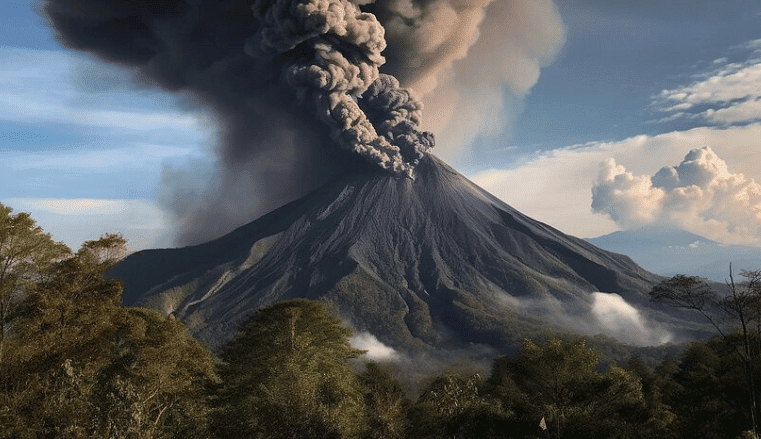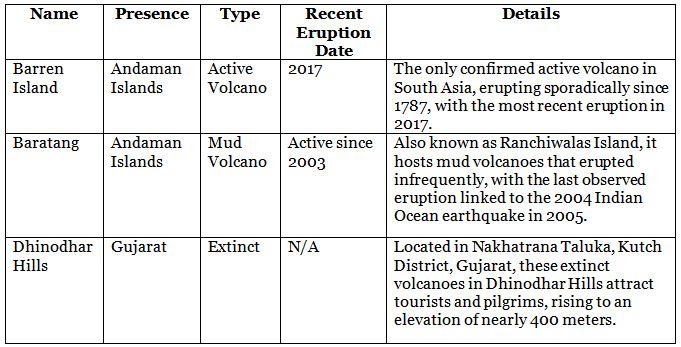Volcanoes | SSC CGL Tier 2 - Study Material, Online Tests, Previous Year PDF Download
| Table of contents |

|
| Volcanoes: A Year of Earth's Fiery Spectacle |

|
| Different Stages of Volcanoes |

|
| Types of Volcanoes |

|
| Major Volcanoes in India |

|
Volcanoes: A Year of Earth's Fiery Spectacle
Introduction
Volcanoes, awe-inspiring landforms, are geological wonders where molten rocks breach the Earth's surface. Acting as vents or fissures, they expel lava, ash, rocks, and gases. Active volcanoes have recently erupted, often fueled by the asthenosphere's magma. The expelled materials, ranging from lava to volcanic bombs, contribute to the diverse elements in their composition, including sulfur and nitrogen compounds, along with traces of argon, hydrogen, and chlorine.

Key Facts
- Volcanoes, shaped by lava and ash eruptions, typically form cone-shaped mountains or hills.
- Magma, upon reaching the surface, transforms into lava, solidifying into rock upon cooling.
- Volcanic eruptions commonly occur at destructive and constructive plate boundaries, not at conservative boundaries.
- Some volcanoes emerge beneath water, along seabeds or ocean floors.
Different Stages of Volcanoes
Volcanoes exhibit various forms based on erupted material, eruption type, and changes since their formation. Three main categories include:
- Active Volcanoes: Likely to erupt or currently erupting.
- Dormant Volcanoes: Not expected to erupt soon.
- Extinct Volcanoes: No anticipated future eruptions.
Reasons for Volcano Formation
Volcanoes originate from magma formation in the Earth's lower crust, driven by the movement of tectonic plates. Plate movement-induced friction leads to earthquakes and volcanic eruptions, creating new pathways for magma to reach the Earth's surface as lava.
Types of Volcanoes
Volcanoes are classified based on eruption style and surface form. Several types include:
Shield Volcanoes:
- Largest active volcanoes, primarily composed of basalt.
- Low explosivity, unless water enters the vent.
Composite Volcanoes:
- Formed by cooler and more viscous lavas than basalt, leading to explosive eruptions.
- Accumulation of pyroclastic material and ashes around vent openings.
Caldera:
- Highly explosive, prone to collapse upon eruption, forming depressions known as calderas.
Flood Basalt Provinces:
- Volcanoes emitting fluid lava covering extensive distances.
Mid-Ocean Ridge Volcanoes:
- Erupt in oceanic areas, particularly along the extensive mid-ocean ridge system.
Major Volcanoes in India

Conclusion
In conclusion, a volcano, an opening in the Earth's crust, releases molten lava, ash, and gases, shaping the landscape and captivating human curiosity with its explosive and dynamic nature.
The document Volcanoes | SSC CGL Tier 2 - Study Material, Online Tests, Previous Year is a part of the SSC CGL Course SSC CGL Tier 2 - Study Material, Online Tests, Previous Year.
All you need of SSC CGL at this link: SSC CGL
|
1335 videos|1433 docs|834 tests
|
FAQs on Volcanoes - SSC CGL Tier 2 - Study Material, Online Tests, Previous Year
| 1. What are the different stages of volcanoes? |  |
Ans. The different stages of volcanoes are the active stage, dormant stage, and extinct stage. During the active stage, the volcano is currently erupting or shows signs of potential eruption. In the dormant stage, the volcano is not currently erupting but has erupted in the past and may erupt again in the future. In the extinct stage, the volcano is not expected to erupt again.
| 2. What are the types of volcanoes? |  |
Ans. The types of volcanoes are shield volcanoes, stratovolcanoes (composite volcanoes), cinder cone volcanoes, and calderas. Shield volcanoes have broad, gently sloping sides and are formed by lava flows. Stratovolcanoes are tall, steep-sided volcanoes built by alternating layers of lava flows and ash. Cinder cone volcanoes are small, steep-sided volcanoes made up of pyroclastic material. Calderas are large, crater-like depressions that form when the top of a volcano collapses into the emptied magma chamber.
| 3. What are some major volcanoes in India? |  |
Ans. Some major volcanoes in India include Barren Island in the Andaman Sea, Narcondam Island in the Andaman Sea, and the Deccan Traps in Maharashtra. Barren Island is the only active volcano in India, while Narcondam Island is a dormant volcano. The Deccan Traps are a large volcanic province in Maharashtra that was formed around 60 million years ago.
| 4. How long does a volcanic eruption typically last? |  |
Ans. The duration of a volcanic eruption can vary greatly depending on the volcano and the eruption style. Some eruptions may last only a few hours or days, while others can continue for weeks, months, or even years. The longest recorded volcanic eruption lasted for over 30 years, such as the ongoing eruption of Kilauea in Hawaii.
| 5. What are some safety measures to take during a volcanic eruption? |  |
Ans. Some safety measures to take during a volcanic eruption include following evacuation orders from authorities, staying indoors to avoid ashfall and toxic gases, wearing protective gear such as masks and goggles, and staying informed through official sources like local emergency management agencies. It is important to have an emergency plan in place and be prepared to evacuate quickly if necessary.
Related Searches















